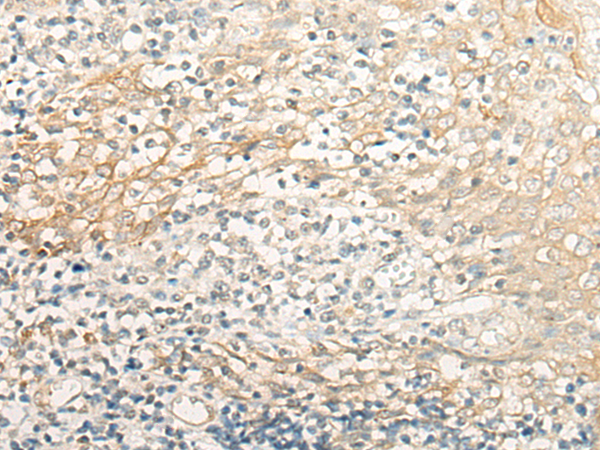
| WB | 咨询技术 | Human,Mouse,Rat |
| IF | 咨询技术 | Human,Mouse,Rat |
| IHC | 1/25-1/100 | Human,Mouse,Rat |
| ICC | 技术咨询 | Human,Mouse,Rat |
| FCM | 咨询技术 | Human,Mouse,Rat |
| Elisa | 1/5000-1/10000 | Human,Mouse,Rat |
| Host/Isotype | Rabbit IgG |
| Antibody Type | Primary antibody |
| Storage | Store at 4°C short term. Aliquot and store at -20°C long term. Avoid freeze/thaw cycles. |
| Species Reactivity | Human |
| Immunogen | Fusion protein of human CRB3 |
| Formulation | Purified antibody in PBS with 0.05% sodium azide and 50% glycerol. |
+ +
以下是关于CRB3抗体的3篇文献示例(信息基于公开研究整理,具体内容建议通过学术数据库核实):
---
1. **文献名称**:*CRB3 regulates tight junction integrity and polarity in mammary epithelial cells*
**作者**:Whiteman EL, Fan S, Hardiman JL, et al.
**摘要**:研究通过CRB3特异性抗体发现,CRB3在小鼠乳腺上皮细胞中通过调控紧密连接蛋白(如ZO-1)维持细胞极性,缺失CRB3会导致细胞屏障功能受损。
2. **文献名称**:*Crumbs3-mediated polarity directs airway epithelial cell fate through the Hippo pathway*
**作者**:Szymaniak AD, Mi R, McCarthy KM, et al.
**摘要**:利用CRB3抗体进行免疫荧光分析,揭示CRB3通过Hippo信号通路调控气道上皮细胞分化,影响组织再生与修复过程。
3. **文献名称**:*CRB3 binds PDZ proteins of the Par complex to orchestrate apical membrane morphogenesis*
**作者**:Roh MH, Liu CJ, Laurinec S, et al.
**摘要**:通过CRB3抗体的免疫共沉淀实验,证明CRB3与Par3/Par6复合物相互作用,参与细胞顶膜形成,提示其在胚胎发育中的关键作用。
---
如需获取全文或更多文献,建议通过PubMed或Google Scholar检索关键词“CRB3 antibody”或“Crumbs3 immune localization”。部分研究可能涉及抗体品牌或克隆号(如Santa Cruz的sc-517307),需根据实验需求选择。
CRB3 (Crumbs homolog 3) is a transmembrane protein belonging to the Crumbs family, which plays a critical role in establishing and maintaining cell polarity, apical-basal membrane organization, and tight junction formation in epithelial and endothelial cells. It is highly conserved across species and is one of three mammalian homologs (CRB1. CRB2. CRB3) of the Drosophila Crumbs protein. CRB3 is predominantly expressed in epithelial tissues, including the kidney, lung, and intestine, where it localizes to the apical membrane domain. Structurally, it contains a short extracellular domain, a single transmembrane region, and a cytoplasmic FERM-binding motif that interacts with scaffolding proteins like PATJ and PALS1 to regulate cell polarity signaling.
CRB3 antibodies are essential tools for studying its role in epithelial barrier function, morphogenesis, and diseases such as cancer or renal pathologies. These antibodies enable detection of CRB3 expression via techniques like Western blotting, immunofluorescence, or immunohistochemistry, often targeting specific regions like its intracellular C-terminal domain. Research using CRB3 antibodies has revealed its involvement in preventing epithelial-to-mesenchymal transition (EMT), modulating ciliogenesis, and maintaining tissue integrity. Dysregulation of CRB3 is linked to impaired cell polarity in cancers and polycystic kidney disease, underscoring its therapeutic and diagnostic potential.
×